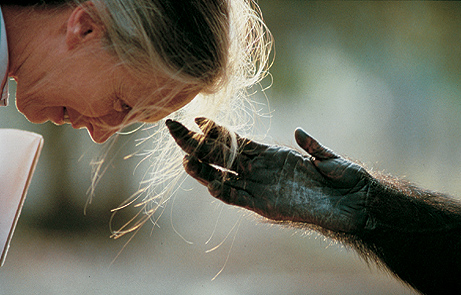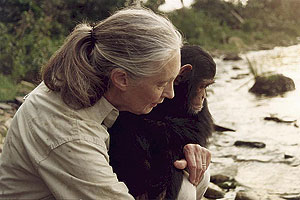
- When
Jane was just over one
year old, her father gave her a toy chimpanzee, which she named
Jubilee. She carried Jubilee with her everywhere. Today, more thatn 65
years later, Jubilee sits on Jane's dresser in England.
- Jane
decided she wanted to
go to Africa after reading the story of Dr. Dolittle, by Hugh Lofting.
It's about a doctor who can talk to animals and who travels to Africa.
Jane also loved the books about Tarzan, though she thought Tarzan's
Jane was rather silly and that she herself would be a better partner
for Tarzan!
- Jane's
dream to live in
Africa and watch and write about animals stayed with her. Although this
was an unusual goal for a girl at the time, Jane's mother encouraged
her, telling her she could make her dreams reality if she worked hard
and believed in herself.
- Goodall
was interested in
animals from her youth; this, coupled with her secretarial training
prompted noted anthropologist Louis Leakey to hire her as his secretary
during a trip to Kenya in 1957 and 1958. It was through her association
with Leakey that Goodall began studying the chimpanzees of Gombe Stream
National Park in July 1960. Leakey arranged for Goodall to return to
the UK where she earned a doctorate in ethology from the University of
Cambridge in 1964.
- In
the summer of 1960, Jane
arrived on the shores of Lake Tanganyika in Tanganyika, East Africa.
The British government had insisted that Jane have a companion. It was
unheard of for a woman to venture into the African forests alone. So
Jane's mother, Vanne, shared the adventure for a couple of months.
- At
first, the Gombe chimps
fled whenever they saw Jane, but she persisted, watching from a
distance with binoculars, and gradually the chimps allowed her closer.
- One
day in October 1960 she
saw chimps David Greybeard and Goliath strip leaves off twigs to make
tools for fishing termites out of a termite mound. Up until this time,
scientists thought humans were the only species to make tools.
- Also
in her first year at
Gombe, Jane observed chimps hunting and eating bushpigs and other small
animals. This was an important discovery because scientists thought
that chimpanzees were primarily vegetarians.
- In
1965, Jane and Hugo
started the Gombe Stream Research Center, which meant graduate students
and others could come and assist with the chimpanzee observations. The
center became a place where students could learn about wild chimpanzees
and how to study them. The center still trains primatologists to this
day. Jane visits Gombe every year and is very involved in the research,
but she no longer does the actual day to day field work. That work is
done by a skilled team of researchers and assistants, many of them from
Tanzania.
- Today
she travels more than
300 days per year talking to audiences about their power to help other
people, animals and the environment. Her institute, which she founded
in 1977, has programs designed to benefit people who are living in
poverty in Africa, and to spread the word about the importance of
conserving the forests and animal populations.
- The
institute also has the
Roots & Shoots global youth program, which helps young people to
learn about the problems in their communities and the world and then
take action toward solving those problems. Today there are more than
7,000 Roots & Shoots groups in 87 countries.


